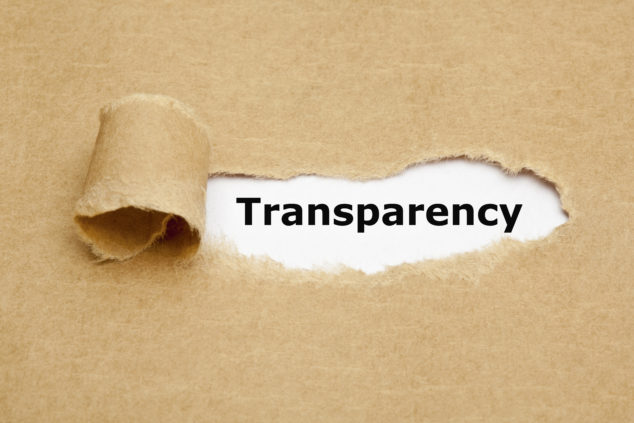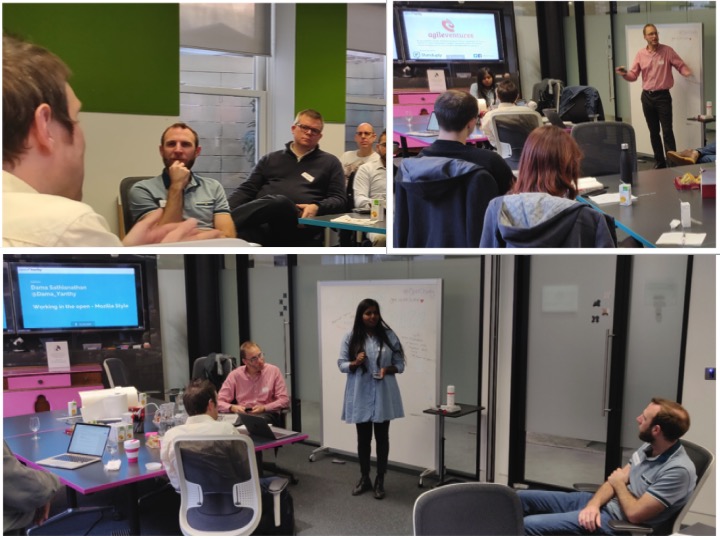
Open Charity recently ran a well-attended morning meetup event with an unconference format. One of the topics covered was ‘Working in the open’. It was such a hot topic that we decided to commit a whole meetup to this theme for further elaboration. For our November 2018 meetup we had 3 guest speakers join us to share their insights and top tips for successfully working in the open.
Useful information about this event
When: Friday, 30 Nov, 2018 at 8:30am
Location: Thoughtworks London
Attendees: 18 including organisers and speakers.
Speakers:
- Adam Petrie from Clic Sargent about their transparency model
- Sam Joseph from AgileVentures about extreme open working
- Dama Sathianathan from Bethnal Green Ventures about Mozilla open leadership
Presentations
Adam Petrie - Clic Sargent
CLIC Sargent generated a lot of buzz in the charity sector with their 2017-18 Impact Report, especially page 27, candidly titled “Hands up, we’re not perfect”. From the top of of the organisation, they established a culture where it is acceptable to make mistakes, provided they learn from them and progress their cause. By ensuring they connect their staff to the core purpose they remained focussed on what’s important, which in turn had a tremendous impact on their supporters, trustees, and caught the eye of the wider industry.
Tips
- Tell your story - the impact report helped to set the tone for the charity. Conferences and Meetups like Open Charity can be good vehicles for storytelling.
- Don’t be afraid of potential flaws - Humility is important. Failures are ok as long as we learn from them.
Sam Joseph, AgileVentures - Extreme Transparency
Sam recommends a certain comfort level with open source software and with the philosophy behind it. Wordpress, Drupal, Plone, MediaWiki; these are some products that are fully open source and may be of interest.
AgileVentures exercise transparency in the extreme. Their Trello boards are publicly accessible and their meetings are streamed publicly in real time. This approach invites scrutiny, reinforces ethical behaviour and builds reputation. The UK government have been doing this with positive results.
Tips
- Familiarise yourself with the ideas behind Open Source software; this model encourages collaboratively working in the open.
- Find ways to work totally in the open; invite public to tune in to your meetings or to view your working documents.
Disadvantages
- There is a risk of exposing ‘secrets’ by accident
- There is an overhead to ensuring full transparency
- Distractions from our work due to unwanted media attention
- Bandwidth constraints can restrict users’ ability to collaborate remotely in real time
Advantages
- Accessing information you need is easier, as nothing is restricted
- Wealth of materials for others to review when onboarding or otherwise learning
- Potential for contribution from unexpected sources
- Garnering trust by exposing the messy creative process
Dama Sathianathan - Working in the open, Mozilla style
The topic of working in the open arose in our last event in September. Dama declared that a culture change is greatly needed in the charity sector. After asking which attendees were familiar with Github (many) and who wanted to get their organisation interested in open source options (most), she went straight into the high-level benefits of the Mozilla principles as a model:
- Working open brings user-centric thinking to your project
- Working open sharpens thinking and spots errors
- Working open achieves maximum impact for your project
Introducing the Mozilla Open Leadership Programme
The Mozilla Open Leadership Programme offers 1-to-1 help from Mozilla mentors. There are 2 tracks: Project Track, Culture Track. Each formalised ‘cohort’ brings together people from various disciplines for peer-to-peer support. Github and Open Canvas (adapted from Lean Canvas) become your tools for maximising impact.
Tips
- Establish an accountability buddy!
- Simple governance structures / code of conduct / community guideline
- Use tools that make it easy to get stakeholder feedback. Automate processes.
- Don’t be afraid to promote your work.
- Commit time to yourself!
- Don’t be hard on yourself
Lots of resources and links are provided in Dama’s portion of the Open Charity event’s slide deck.
Questions and Answers for our presenters
Q: What do you find drives the fear of failure internally?
A: (Adam) The fallacy that if a supporter sees you’ve failed, they’ll stop supporting. Charities that got it right are saying “of course we’re not perfect”.
Q: How on earth did you convince your trustees to be open publicly?
A: (Adam) We had this culture from the very top. So it’s hard to explain to you how to get there. We wished we had set up some evaluation metrics around openness to back up our approach to openness. We have some qualitative feedback from our supporters but not quantitative.
Q: Has anyone noticed any impact on recruitment (positive or negative)?
A: (Sam) Both of those things. Fear of openness or love of openness has had both positive and negative effects. Because of the transparency of process, potential candidates have already been able to ‘try out’ our way of working; this has had a positive effect on recruitment.
(Adam) communicating in an open way lends itself a certain tone -- marketing comms are polished, the HR recruitment materials is usually very formal, but the blog is more frank/human in its tone.
Q: Working with a big NGO, there’s a lack of internal openness. Trying to open doors, get everyone on the same page, its very uncomfortable.
A: (Dama) Take a look at “Sociocracy 3.0”. There is always a contact between groups. (Sam) we are small, but our standups are streamed openly to the world. (Greg - one of the organisers): Over the years we have established twice-weekly standups, which are actually quick demos and we invite other departments to come and talk about what they’re doing. More recently we have been video-recording them and sharing .
Q: How do you get large groups, remote groups participating in these large standups?
A: (Sam) We have no office. We are always online. Google Hangout, Zoom, Skype.
(Dama) The Open Leadership Programme from Mozilla is entirely remote. They invite in the right tools, like Zoom and Google hangouts. Facilitation skills can really come in handy.
Lightning Talks
Chris from Beacon CRM
The data from CRM are very interesting, for example going into an impact report.
Geotagging on the wells around the world. We have been helping charities to navigate the constraints of GDPR protection vs open working and open data.
Mike from Ayup
Two interesting projects we’re doing:
- Social subscribing platform (Kingston council) - huge piece of co-design. Open source, working in the open, hangouts, trello boards.
- Working with CAST on an MVP prototype of HIV appointments, creating an open source system to be rolled out nationwide. London next week in Metro Centre, then Yorkshire.
Greg from Cancer Research UK
Spoke briefly about participating in a large-scale retrospective meeting for an entire department (50+). There’s a post on LinkedIn to learn more.
In Conclusion
The topics presented at this Open Charity meetup were riveting! There was a positive, friendly and informal vibe to the session. The format allowed for information exchange, audience engagement and networking. The attendees came away armed with tips on open working which they can apply in their organisations immediately.
The venue and food/drink were provided by Thoughtworks and are much appreciated! Thanks to Adam (@CLIC_Sargent), Sam (@AgileVentures) and Dama (@Dama_Yanthy) for presenting.

Adam explains CLIC Sargent's open approach to the attendees, Sam Joseph talks about extreme transparency, Dama Sathianathan describes the Mozilla Open Leadership Program
- Log in to post comments
